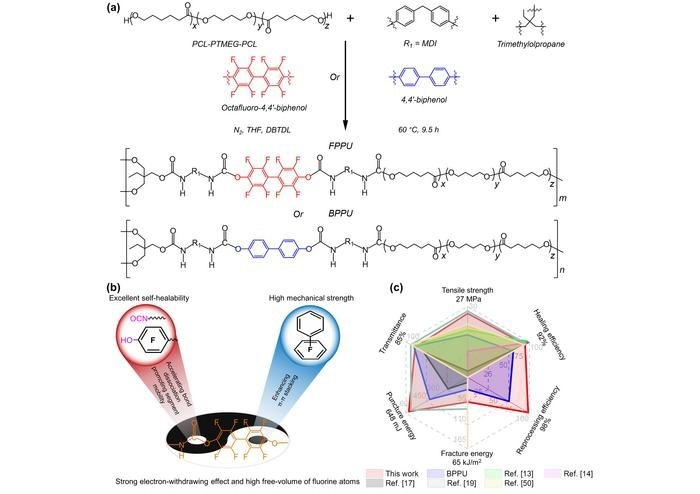Reviewed by Lexie CornerApr 29 2024
Researchers from the Donghua University in China designed a fluorinated phenolic polyurethane (FPPU) elastomer, overcoming the traditional trade-off between mechanical strength and self-healing capabilities. This innovative material exhibits exceptional puncture energy, tensile strength, and self-healing efficiency, opening doors for various high-performance elastomer applications. The research was published in the journal Science Bulletin.
 a) The chemical structure of the synthesized elastomers. (b) The representative illustration of FPPU elastomer, highlighting the electron−withdrawing effect of OFBP conducive to the dissociation of phenol−carbamate bonds and π−π stacking interactions, and the high free−volume resulting from OFBP promoting polymeric chain mobilities. (c) The comparison of properties for representative elastomers and synthesized FPPU. FPPU elastomer exhibited excellent comprehensive properties, with the highest record puncture energy among the elastomers. Image Credit: Science China Press
a) The chemical structure of the synthesized elastomers. (b) The representative illustration of FPPU elastomer, highlighting the electron−withdrawing effect of OFBP conducive to the dissociation of phenol−carbamate bonds and π−π stacking interactions, and the high free−volume resulting from OFBP promoting polymeric chain mobilities. (c) The comparison of properties for representative elastomers and synthesized FPPU. FPPU elastomer exhibited excellent comprehensive properties, with the highest record puncture energy among the elastomers. Image Credit: Science China Press
The research was carried out by Zhengwei You and Junfen Sun.
Typically, there is a trade-off between high mechanical strength and dynamic self-healing due to mutually exclusive mechanisms. However, this team has devised a solution by designing and producing a fluorinated phenolic polyurethane (FPPU) elastomer based on octafluoro-4,4’-biphenol to surmount this challenge.
Through the π−π stacking between aromatic rings and the free volume among polymer chains, this fluorine-based motif not only tunes interchain interactions but also enhances the reversibility of phenol−carbamate bonds through the electron-withdrawing effect of fluorine atoms.
When compared to its non-fluorinated counterpart, Biphenolic Polyurethane (BPPU) elastomer, the developed FPPU elastomer exhibits the highest recorded puncture energy (648.0 mJ), high tensile strength (27.0 MPa), and excellent self-healing efficiency (92.3 %). It also has low surface energy (50.9 MJ m−2), notch-insensitivity, and reprocessability.
The team has prepared an anti-fouling Triboelectric Nanogenerator (TENG) with a self-healing and re-processable elastic substrate by utilizing the benefits of FPPU elastomer. Compared to the TENG made of BPPU elastomer, this electronic device has an ultrahigh peak open-circuit voltage of 302.3 V because fluorine atoms have a stronger electron affinity than hydrogen atoms.
A stretchable and healable conductive composite is also prepared. This work opens up a new avenue for building high-performance elastomers and will facilitate several new applications.
Journal Reference:
Jia, Y., et al. (2024) A fluorine-based strong and healable elastomer with unprecedented puncture resistance for high-performance flexible electronics. Science Bulletin. doi.org/10.1016/j.scib.2024.03.047